MATTAWA RIVER
ONTARIO
The Mattawa River is a natural passage through the Algonquin Highlands between Lake Nipissing and the Ottawa River. It rises 3.5 km east of Lake Nipissing and flows east along an ancient fault line into the Ottawa River. With the French River, which flows west from Lake Nipissing, the Mattawa provided a vital link for natives and early Europeans between the Ottawa River and the Great Lakes.
Europeans who first came to this area in the early 17th century followed this old Indian route and called it "La Petite Rivière". Later, the river was named "Mattawa", Algonkian for "junction of waterways" or "river with walls that echo its current". The Mattawa was one of the most challenging sections of the Voyageur Waterway, the main fur-trade canoe route between Lachine and the northwest, Canada' s main highway of exploration and commerce for more than 200 years. Today the Mattawa is used mainly by tourists and day visitors, providing some of the finest canoeing in Ontario in a natural environment little changed from the time of the Voyageur.

Re-enactment of Voyageur travel in a 'Canot de Maître'
On the basis of the river' s natural, historical, and recreational value, a 43 kilometre section of the Mattawa between the west boundary of Mattawa River Provincial Park and the east boundary of Samuel de Champlain Provincial Park was designated a Canadian Heritage River in January, 1988. Because the French River was designated in 1986, most of the historic river route linking the Ottawa River with Lake Nipissing and Georgian Bay is now protected under the CHRS program.
GEOGRAPHY
The Mattawa River rises in Trout Lake, 198.5 metres above sea level, and drops 50 metres over the 43 km distance to the Ottawa River. Its watershed is 117,000 hectares of forested Canadian Shield. Its vegetation and wildlife are typical of both Boreal and Great Lakes-St. Lawrence Forests. Large mammals here include white-tailed deer, black bear, moose, and timber wolf. Winters are cold (-10ºC or 13ºF in January) and summers are warm with average day-time temperatures of 22.5ºC (75ºF). Precipitation is low with 92cm (36") of rain during the summer and only 56 cm (22") of snowfall during winter.
The designated section of the Mattawa lies between North Bay (pop. 52,000) and Mattawa (pop. 2,686) along the imaginary line dividing northern and southern Ontario. It is protected within the two provincial parks administered by the Ontario Ministry of Natural Resources. With the exception of a few private cottages on lakes bordering the river, this section is buffered by 122 m of wooded shoreline on either side and comprises 5,810 ha. of the Mattawa River watershed.
Upstream of the designated area, Mattawa River shorelands are developed with private homes and cottages. Downstream, lands are privately owned but mostly undeveloped. Both these areas are administered by the local municipalities and by the North Bay Mattawa Conservation Authority.
HISTORY
The Mattawa's heritage river designation was based primarily on its human heritage values which are associated with native history, exploration, and the fur trade. The river also played a brief role in the square timber trade during the 1880' s and in the mining era of the 1940's and 50's.
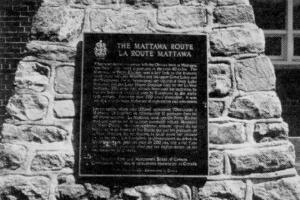
Commemorating "The Matttawa Route"
Native History: Archaeological evidence at 28 sites suggest that the Mattawa was travelled by natives for up to 6,000 years. One of only two ochre mines known in Ontario is located at Porte de l'Enfer, ochre being a reddish-colored pigment used by natives for drawing pictographs. Artifacts such as rock pits, cairns, arrowheads, and stone tools indicate native habitation and fishing sites along Trout and Talon Lakes, at Grasswell Point and at Campion Portage.
Exploration of Canada: The Mattawa was part of a traditional aboriginal route between the St. Lawrence valley and the upper Great Lakes, and it was over this route that Indians led the first European travellers into the interior of the continent. Champlain sent the interpreter, Étienne Brûlé, the first white man to see the Mattawa, inland with a band of Algonquins in 1610, and five years later himself accompanied a party of Huron over the route, producing the first published map of the area. As it had been for the Indians, this became the major west-bound highway for the European traders and missionaries who followed Champlain.
Fur-Trade: For over two centuries, the fur trade was almost the sole reason for a European presence in Canada outside of the settlements along the Atlantic coast and St. Lawrence, and the Mattawa was an important link in the commercial network that eventually extended across the continent. This short stretch was perhaps the most demanding on the 2,000 km Voyageur Waterway between Montreal and Fort William, having 11 of the route's 38 portages. Nine of the 11 portages are much as they were found by the Voyageurs, and all still have their original French names. The significance of the Mattawa Route is commemorated by a provincial plaque and a national Historic Sites and Monuments Board of Canada plaque in Mattawa, and by a Canadian Heritage Rivers System plaque in Champlain Park.
The railway passed through Mattawa in 1881, ending the river's use as a fur-trade and lumber transportation corridor. The Trans-Canada Highway opened the region to tourism and today the area is used almost exclusively for cottaging, boating, fishing and wilderness canoeing.
NATURAL HERITAGE
Designation of the Mattawa as a Canadian Heritage River was also based on its outstanding natural features:
- The 600 million year old Mattawa River fault, visible in the gorge below Paresseux Falls, still causes minor earthquakes in the area;
- Evidence of the once, much larger Mattawa River, a post-glacial spillway which drained the Great Lakes into the Ottawa River for 6,000 years, is seen in several locations: There are potholes at Portage de Talon and numerous abandoned cataracts and river channels, such as the boulder pavement between Pine Lake and McCool Bay, 12-15 m above the present river;
- Ontario's only major deposit of brucite marble, a colouring agent used in paper production, was discovered near Talon Chute. It was the first deposit found in Canada, of a mineral which is still nationally rare;
- Special vegetation and wildlife features include: original stands of red and white pine trees; large swamp forests near Pine Lake; two plant species considered rare in Ontario - the awlwort and waterwort; and more than 200 species of birds which include wood ducks and cliff nesting ravens;
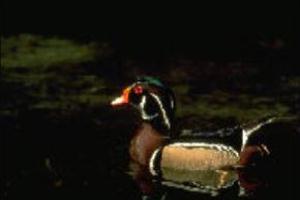
A Wood Duck
- Areas of exceptional natural beauty are numerous: there are two waterfalls, Talon Chutes (3 m) and Paresseux Falls (8 m); the Shields Bay "tombolo", a sand bar connecting an island to the mainland; the south-facing scarp of the Mattawa River fault; and the gorge-like valley between Pimisi Bay and Champlain Park.
RECREATION
The Mattawa River' s designation was also based on the outstanding combination of recreational opportunities it offers annually to thousands of people from North Bay, Mattawa, Ottawa, and Toronto who visit the Mattawa River and Samuel de Champlain provincial parks. These include:
- exceptional river and lake canoeing used by more than 2500 canoeists each year, in an area of great natural beauty;
- good fishing for pickerel, small-mouth bass, northern pike, muskellunge, and lake trout;
camping at developed campsites and group campgrounds in Champlain Park and at 6 designated canoe campsites along the river;
- hiking on glacial-era river beds high above the present river and on 30 km of designated trails;
- exciting on-site appreciation of the river's cultural heritage. The same portages and camp-sites once used by Indians, explorers, voyageurs and lumbermen can still be used. There are also interpretive programs in Champlain Park at the Voyageur Heritage Centre where, among other exhibits, can be seen an authentic replica of a "Canot de Maître";
- nature observation and study for amateur and professional photographers, bird watchers, botanists, naturalists and geologists; and,
- winter recreation in the form of ice-fishing and cross-country skiing.
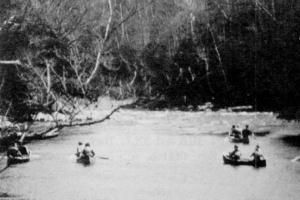
Group of canoeists entering Des Roches Rapids
VISITOR INFORMATION
Canoeing: The Mattawa offers superb river and lake canoe trips of 1 to 4 days duration from May to mid-October. The river's short, but exciting fast water gorges, and 9 well-marked portages - all shorter than 500 m - make it suitable for visitors with limited experience in open canoes and challenging for more highly skilled canoeists able to shoot some of the rapids. Visitors should be cautious crossing Trout and Talon lakes which can be hazardous in windy weather. Throughout the system, all drinking water should be treated.
Though the river is navigable in either direction, canoe trips generally commence upstream and follow three popular routes: a 2-4 day, 58 km trip from the west end of Trout Lake at Armstrong Park to Mattawa; a 1-3 day trip along the 33 km designated river section from the east end of Trout Lake to Campion Rapids in Champlain Park; and a 13.5 km day trip through the most scenic, natural section of the river, starting at Blanchard's landing on Talon Lake and ending at Campion Rapids.
Access: The Mattawa is located 350 km via Hwy 11 north of Toronto and 300 km on Trans-Canada Hwy 17 northwest of Ottawa. It is also within a day's drive of many smaller centres in central Ontario and western Quebec - Sudbury, Parry Sound, Huntsville, Barrie, Témiscaming, Noranda, and Rouyn. Several highways, including the Trans-Canada, bring visitors directly into the region.
Boat access points from well-developed gravel roads have been developed all along the river's south shore and at Trout Lake. Access from the east by canoe from the Ottawa River or from the west via Lake Nipissing and the La Vase portages can provide continuity in retracing the Route of the Voyageurs.
North Bay is serviced by daily scheduled airlines and both Mattawa and North Bay have bus and passenger rail service. Most lakes in the system are also accessible by float plane.
Accomodation and Services: Mattawa and North Bay, the region's primary service communities, provide the full range of community services and facilities year-round. Resorts, lodges, hotels, motels, and campgrounds are located along the region's highways and in numerous communities within an hour's drive. From late June until Labour day, Samuel de Champlain Provincial Park provides 216 developed campsites, two group campgrounds, visitor services, interpretive programs, and canoe rentals.
Topographic Maps: National Topographic Series Maps for the Mattawa River are: 1:250,000 scale - 31L and 1:50,000 scale - 31L6 and 31L7. They can be purchased from: Canada Map Office, 615 Booth Street, Ottawa, K1A 0E9.

Les Epines Rapides and the historic de la Rose Portage
FURTHER INFORMATION
Mattawa River and Samuel de Champlain Provincial Parks - Services, Permits and Regulations: Ministry of Natural Resources, P.O. Box 3070, North Bay, Ont. P1B 8K7; or, Mattawa River/Samuel de Champlain Provincial Parks, P.O. Box 147, Mattawa, Ont. P0H lV0.
Tourist Information: Ontario Travel, Queen's Park, Toronto, Ont. M7A 2E5; or, Almaquin-Nipissing Travel Association, Regional Tourist Centre, Seymour St. and North Bay Bypass, Box 351, North Bay, Ont. P1B 8H5.
Canadian Heritage Rivers System: Secretary, Canadian Heritage Rivers Board, Ottawa K1A 0H3; or, Ontario Member, Canadian Heritage Rivers Board, c/o Director, Parks Ontario, Queen's Park, Toronto, Ont. M7A 1W3.
Additional Reading:
- Reid, Ron and Janet Grand. Canoeing Ontario's Rivers. Douglas and McIntyre. Toronto. 1985.
- Rumney, George R. "The Ottawa-Nipissing Canoe Route in Early Western Travel". Canadian Geographical Journal. January, 1951.
- Ontario Travel. "Ontario Traveller's Encyclopedia". Toronto. M7A 2E5. 1988.
- Voyages: Canada's Heritage Rivers - Lynn E. Noel, editor. Published by Breakwater Books of Newfoundland and sponsored by QLF/Atlantic Centre for the Environment. Newfoundland orders
toll free: l-800-563-3333, Canadian orders and inquiries outside Newfoundland toll free: 1-800-387-0172, U.S. orders and inquiries toll free: 1-800-805-1083. Discount available from Canadian River Management Society, Tel. 819-994-3011.

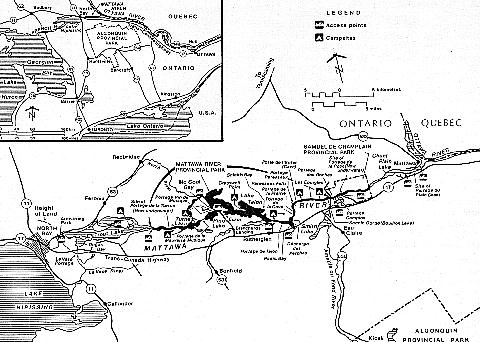
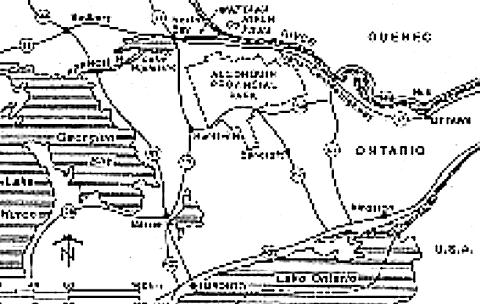
Written and edited by: Mike Greco
Photos Courtesy of Friends of the Mattawa, M.Greco and Parks Canada
Maps Created by: Diamentino Batista
Last Revised:1989








